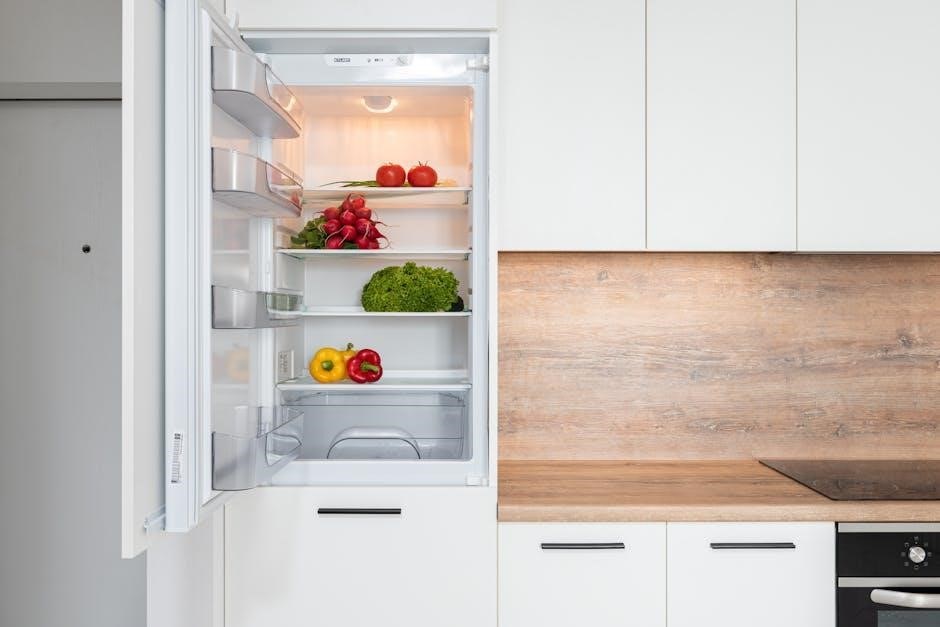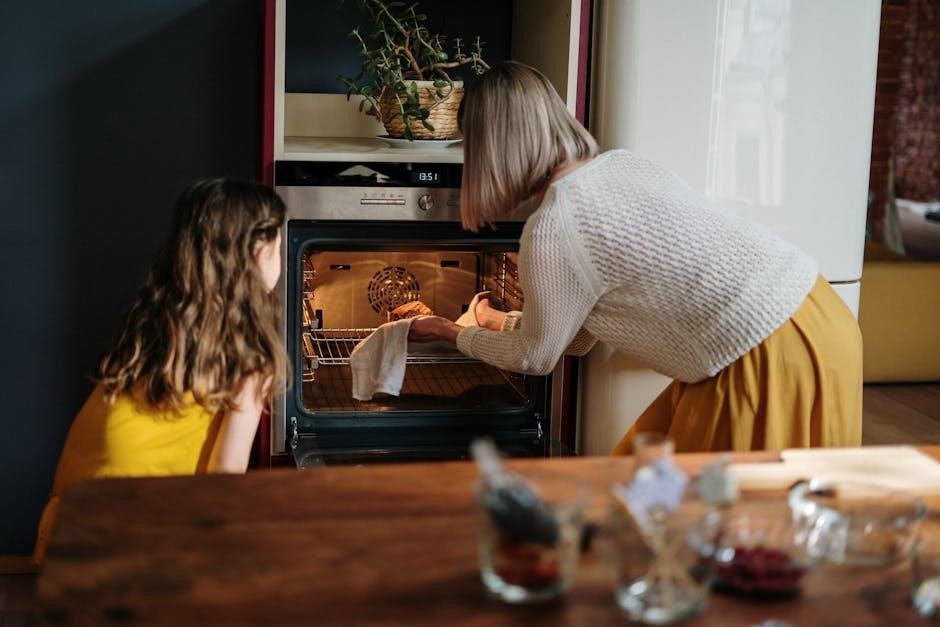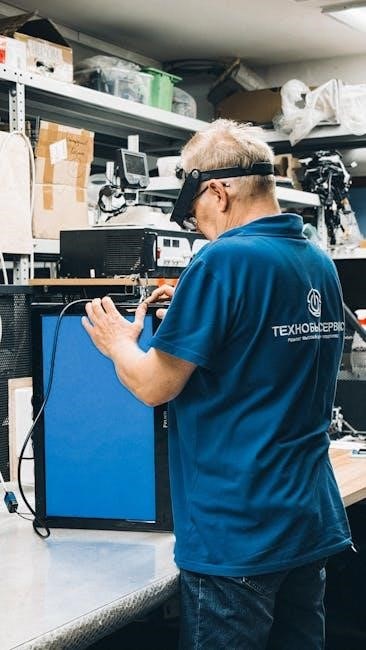This guide provides essential insights into troubleshooting Norcold refrigerators, addressing common issues and offering practical solutions to ensure efficient and safe operation always.
1.1 Background and Importance of Troubleshooting
Troubleshooting Norcold refrigerators is crucial for ensuring reliable operation, especially in RVs where consistent cooling is vital. Common issues like improper cooling or ignition failures can lead to food spoilage and safety hazards. Regular troubleshooting helps identify and resolve problems early, preventing escalation. It also empowers users to address minor issues independently, reducing reliance on external repairs. By understanding the system and its components, owners can maintain optimal performance, extend the appliance’s lifespan, and ensure safe functionality during travels. This guide provides a structured approach to diagnosing and resolving common problems effectively.
1.2 Understanding the Norcold Refrigerator System
Norcold refrigerators operate using a gas absorption cooling system, primarily fueled by propane. This system relies on a heat source to drive the cooling process, making it ideal for RVs with limited electricity. The system includes components like the burner, absorption unit, and cooling fins. Proper ventilation and electrical connections are essential for safe and efficient operation. Understanding how these elements interact helps in identifying potential issues and performing effective troubleshooting. Regular maintenance ensures optimal performance and longevity of the appliance, especially in mobile environments where conditions can vary significantly.

Safety Precautions for Troubleshooting
Adhering to safety guidelines is crucial when troubleshooting your Norcold refrigerator. Ensure the gas supply is turned off and the appliance is unplugged to prevent electric shock. Always check for propane leaks and proper ventilation. Follow the manufacturer’s instructions carefully to avoid accidents and ensure safe repairs.
2.1 Essential Safety Tips Before Starting
- Always disconnect the power supply to the refrigerator before performing any repairs to avoid electric shock.
- Ensure the gas supply is turned off and verify there are no leaks in the propane system.
- Check that the refrigerator is properly ventilated to prevent the accumulation of flammable gases.
- Never attempt repairs without consulting the official Norcold service manual or guidance from a qualified technician.
- Wear protective gear, including gloves and safety glasses, when handling electrical or gas components.
- Ensure the refrigerator is on a level surface before starting any troubleshooting to maintain stability.
2.2 Understanding Error Codes and Warnings
Understanding error codes and warnings is crucial for effective troubleshooting. Common codes like “DC LO” indicate low DC voltage, while “OP” signals an overpressure issue. “PS” refers to power supply problems, and “FL” indicates a flame failure. Always refer to the Norcold service manual for specific code definitions, as they vary by model. Addressing these codes promptly helps prevent further damage and ensures safe operation. Familiarize yourself with the error code chart in your manual to diagnose issues accurately and efficiently.
Common Issues with Norcold Refrigerators
Norcold refrigerators often face issues like improper cooling, ignition failures, overfreezing, unusual noises, and power supply problems. These common problems can disrupt performance and require timely fixes.
3.1 Refrigerator Not Cooling Properly
If your Norcold refrigerator isn’t cooling properly, check the power supply and ensure 12V DC is available. Verify the thermostat is set correctly and vents are unblocked. Inspect the cooling unit for damage or failure. Ensure proper gas flow if using propane and check for ignition issues. If problems persist, consult the service manual or contact an authorized technician to address potential system malfunctions or component failures. Regular maintenance and correct operation are crucial for optimal performance.
3.2 Refrigerator Will Not Ignite or Stay Lit
If your Norcold refrigerator fails to ignite or stay lit, check the propane supply and ensure the tank is not empty or closed. Verify the igniter is functioning and free from debris. Ensure the burner and vents are clear of blockages. Check the DC voltage supply, as low voltage can prevent ignition. Consult the service manual for specific troubleshooting steps, and if issues persist, contact an authorized technician. Proper ignition is critical for safe and efficient operation, so addressing this promptly is essential to avoid further complications.
3.3 Overfreezing or Ice Buildup Issues
Overfreezing or excessive ice buildup in your Norcold refrigerator can disrupt performance and damage components. Check the thermostat settings to ensure they are not set too low. Inspect the drain for blockages, as poor drainage can lead to ice accumulation. Verify proper airflow around the unit, as restricted vents may cause cooling inefficiencies. Regular defrosting is essential to prevent ice buildup. If issues persist, consult the service manual for diagnostic steps or contact an authorized technician to address potential system malfunctions and restore optimal operation.
3.4 Unusual Noises or Vibrations
Unusual noises or vibrations in your Norcold refrigerator can indicate underlying issues. Common causes include malfunctioning fans, a faulty cooling unit, or improper installation. Check the evaporator and condenser fans for obstruction or wear. Ensure the refrigerator is level, as misalignment can cause vibrations. Inspect the propane system for leaks or blockages if noises are gas-related. If issues persist, consult the service manual for diagnostic procedures or contact an authorized technician to address potential component failures and restore smooth operation.
3.5 Power Supply Problems
Power supply issues can disrupt your Norcold refrigerator’s operation. Ensure a stable 12V DC supply, as low voltage can cause malfunctions. Check circuit breakers and fuses, and verify all electrical connections are secure. If using propane, confirm the gas supply is open. For AC operation, ensure the switch is set correctly. Consult the service manual for troubleshooting steps, such as voltage checks, to identify faulty components. Addressing power supply problems promptly can prevent further damage and restore proper functionality to your refrigerator.

Diagnostic Procedures for Norcold Refrigerators
Start by checking the power supply, ensuring 12V DC is available. Verify electrical connections and test for gas leaks if using propane. Inspect vents for blockages and ensure proper airflow. Use diagnostic tools like multimeters to identify faulty components. Follow systematic steps to isolate issues, referencing the service manual for detailed procedures and solutions.
4.1 Checking the Power Supply and Electrical Connections
Ensure the refrigerator receives a stable 12V DC power supply. Verify all electrical connections are secure and free from corrosion. Check the circuit breaker or fuse box to confirm power is not interrupted. Use a multimeter to test voltage at the refrigerator’s terminals. If voltage is below 10.5V, it may indicate a wiring issue or faulty converter. Inspect the AC-DC switch and ignitor switch for proper function. Loose or damaged connections can prevent the refrigerator from operating correctly. Always disconnect power before servicing to avoid electrical shock.
- Check battery voltage and charging system if issues persist.
- Ensure proper grounding to prevent malfunction or safety hazards.
4.2 Verifying Gas Supply and Ignition Systems
Ensure the propane tank is turned on and sufficient gas is available. Check the gas line for leaks using a soap solution. Verify the igniter and burner flame are functioning properly. If the burner does not light, inspect the igniter for damage or corrosion. Ensure the gas valve is fully open and the vent system is unobstructed. Test the flame sensor for proper operation. If issues persist, consult the service manual for specific diagnostic procedures. Always ensure proper ventilation to avoid gas accumulation and potential safety hazards.
- Check for blockages in the venting system.
- Ensure the igniter switch is in the correct position.
4.3 Inspecting Vents and Airflow
Proper ventilation is crucial for Norcold refrigerators to function efficiently. Start by inspecting the vents for blockages, such as dust or debris. Ensure all vents are unobstructed to allow adequate airflow. Check the exterior vent for proper installation and alignment. Verify that the refrigerator is level, as improper leveling can restrict airflow. Clean or replace any clogged air filters. Ensure the surrounding area is clear of obstructions. If airflow is restricted, the refrigerator may overheat or fail to cool properly. Always refer to the service manual for specific venting requirements.
- Inspect both intake and exhaust vents for blockages.
- Ensure the refrigerator is installed level to maintain airflow.
4.4 Testing the Thermostat and Temperature Settings
Testing the thermostat and temperature settings is crucial for ensuring your Norcold refrigerator operates efficiently. Start by verifying the thermostat is set to the correct temperature. If the refrigerator is not cooling, check if the thermostat is functioning correctly. Ensure the temperature setting matches the desired level. If issues persist, test the thermostat for continuity using a multimeter. Also, check the temperature sensor for proper placement and functionality. Adjust settings as needed to maintain optimal cooling. Refer to the service manual for specific instructions on testing procedures.
- Verify thermostat settings align with desired temperatures.
- Test thermostat continuity for proper electrical connection.
Advanced Troubleshooting Techniques
Advanced troubleshooting involves specialized tools and methods to diagnose complex issues. Use a multimeter for electrical diagnostics, inspect gas lines for leaks, and test the cooling unit’s absorption system performance.
5.1 Using a Multimeter for Electrical Diagnostics
A multimeter is a crucial tool for advanced troubleshooting. It measures voltage, current, and resistance, helping identify electrical issues. Begin by ensuring the RV’s DC voltage supply to the refrigerator is within the recommended range (10.5 to 15.4 volts). Use the multimeter to test circuit continuity and verify proper connections. Check for voltage drops across wires and components, which can indicate faulty parts or corrosion. Additionally, test the thermostat and sensor resistances to ensure they function correctly. This step-by-step approach helps pinpoint electrical faults efficiently, ensuring your Norcold refrigerator operates smoothly.
5.2 Checking for Gas Leaks and Proper Ventilation
Gas leaks and poor ventilation are critical issues that require immediate attention. Always ensure the propane supply is turned off before inspecting. Use a gas leak detector or soapy water to check connections for bubbles, which indicate leaks. Verify that all vents are clear and functioning correctly, as improper ventilation can lead to carbon monoxide buildup or reduced efficiency. Ensure the refrigerator uses only approved ventilation systems, as specified in the manual. Additionally, check that the burner flame appears blue, indicating proper combustion. Addressing these issues ensures safe and efficient operation of your Norcold refrigerator.
5.3 Testing the Cooling Unit and Absorption System
Testing the cooling unit and absorption system is vital for diagnosing issues. Ensure the unit is clean and free from blockages. Check for proper ammonia flow and verify the absorption process is functioning correctly. Inspect the cooling unit’s condition for any signs of damage or wear. If cooling performance is poor, it may indicate a failure in the absorption system. Use a multimeter to test electrical components connected to the cooling unit. Ensure all connections are secure and functioning properly. Addressing these issues promptly ensures optimal performance and prevents further damage to the system.

Solutions to Common Problems
This section outlines practical solutions for common Norcold refrigerator issues, ensuring efficient and reliable operation. Address cooling, ignition, and power problems with targeted fixes and maintenance tips.
6.1 Resetting the Refrigerator and Electrical Systems
Resetting your Norcold refrigerator and electrical systems can often resolve operational issues. Start by ensuring the power supply is stable and switches are in the correct position. Toggle the AC-ELECTRIC STANDBY-DC switch to reset the system. If issues persist, check for tripped circuit breakers or loose connections. Allow the refrigerator to restart and stabilize before testing performance. Regular resets can prevent malfunctions and ensure optimal cooling. Always consult the manual for specific reset procedures tailored to your model. This step is crucial for maintaining efficiency and addressing common electrical glitches effectively.
6.2 Adjusting the Thermostat and Temperature Settings
Proper thermostat and temperature settings are crucial for efficient refrigerator operation. Start by ensuring the thermostat is set to the desired temperature. Check that the AC-ELECTRIC STANDBY-DC switch is in the correct position for your power source. If the refrigerator is not cooling, verify that the thermostat is not set too high. Adjust the temperature control gradually, allowing the system time to respond. Ensure vents are unobstructed for proper airflow. If issues persist, consult the manual for specific calibration instructions. Correct settings optimize performance and prevent overfreezing or undercooling, ensuring reliable operation.
6.3 Cleaning and Maintaining Vents and Coils
Regular cleaning of vents and coils is essential for optimal performance. Ensure all vents are unobstructed to maintain proper airflow, as blockages can lead to overheating or poor cooling. Use a vacuum or soft brush to remove dust and debris from the coils. Check the exterior vents for dirt or obstructions and clean them thoroughly. Proper maintenance prevents reduced efficiency and potential system failure. Always unplug the refrigerator before cleaning to avoid electrical hazards. Regular upkeep ensures consistent cooling and prolongs the lifespan of your Norcold refrigerator.
6.4 Replacing Faulty Parts and Components
Replacing faulty parts is crucial for restoring your Norcold refrigerator’s performance. Start by identifying the issue through diagnostic tests. Consult the service manual for specific part identification and replacement procedures. Ensure all power sources are disconnected before starting repairs. Use genuine Norcold parts to maintain compatibility and safety. If unsure, contact an authorized service center for professional assistance. Regularly inspect components like ignitors, thermostats, and gas valves to prevent future malfunctions. Timely replacements ensure efficient operation and extend the appliance’s lifespan.

Maintenance and Prevention Tips
Regular maintenance ensures optimal performance and prevents issues. Clean vents, inspect electrical connections, and defrost as needed. Check gas lines and thermostat settings for efficiency.
7.1 Regular Maintenance Schedule
Regular maintenance is crucial for optimal performance. Check electrical connections and ensure proper voltage supply monthly. Inspect gas lines for leaks and clean vents every 3-6 months. Defrost the refrigerator when ice buildup exceeds 1/4 inch. Ensure thermostat settings are accurate and adjust as needed. Schedule professional inspections annually to identify potential issues early. Proper maintenance prevents breakdowns and extends the lifespan of your Norcold refrigerator, ensuring reliable operation during your travels.
7.2 Proper Defrosting and Ice Management
Regular defrosting is essential to prevent ice buildup, which can reduce efficiency and cause damage. Defrost when ice exceeds 1/4 inch thickness. Turn off the refrigerator and allow it to thaw naturally or use a hair dryer on a low setting. Avoid chipping ice with sharp objects to prevent damage. After defrosting, ensure proper drainage and inspect seals for integrity. Regular checks and maintaining optimal temperatures can help minimize ice accumulation, ensuring smooth operation and extending the appliance’s lifespan.
7.3 Optimizing Refrigerator Performance
Optimizing your Norcold refrigerator’s performance involves regular maintenance and smart usage. Ensure proper ventilation by keeping vents unobstructed and check electrical connections for stability. Maintain the RV on a level surface to prevent uneven cooling. Regularly inspect the cooling unit and seals for wear. Avoid exposing the fridge to extreme temperatures and overload. Clean condenser coils periodically to enhance efficiency. By addressing these factors, you can maximize performance, reduce energy consumption, and extend the lifespan of your Norcold refrigerator, ensuring reliable cooling during your travels.

Resources and Further Assistance
Access Norcold service manuals, authorized service centers, and online forums for troubleshooting guides, repair information, and expert advice to resolve issues efficiently and effectively always.
8.1 Downloading the Norcold Service Manual
The Norcold service manual is a vital resource for troubleshooting and repairing your RV refrigerator. It provides detailed diagnostic procedures, repair guidelines, and maintenance schedules. Available for free download from Norcold’s official website or authorized dealers, the manual covers specific models like the N641, N821, and N641. Ensure you select the correct model to match your refrigerator. The manual includes sections on safety precautions, electrical connections, and gas system checks. By following the guide, you can identify and resolve issues efficiently. Always refer to the latest version for updated information and adhere to safety guidelines to avoid potential hazards during repairs.
8.2 Contacting Authorized Service Centers
For complex issues or professional assistance, contacting an authorized Norcold service center is recommended. These centers employ factory-trained technicians who specialize in Norcold refrigerator repairs. Visit Norcold’s official website or contact their customer support to locate the nearest authorized service center. Ensure to provide your refrigerator’s model number (e;g., N641, N821, N641) for accurate assistance. Authorized centers guarantee genuine parts and adherence to safety standards, ensuring reliable and efficient repairs for your RV refrigerator.
8.3 Online Forums and Community Support
Online forums and RV communities offer valuable resources for troubleshooting Norcold refrigerators. Websites dedicated to RV repairs often feature discussions on common issues, error codes, and DIY solutions. Users share their experiences, providing practical advice and workarounds. Popular forums include RV repair groups and specialized appliance communities. Searching for specific topics, like “N641 error codes” or “Norcold refrigerator not cooling,” can yield helpful insights. These platforms foster collaboration, allowing owners to learn from others and resolve issues efficiently. Engaging with these communities can save time and reduce frustration when dealing with complex problems.
Ensure all troubleshooting steps are verified for safe and efficient operation. Double-check electrical connections, gas supply, and thermostat settings before restoring full use of the refrigerator.
9.1 Ensuring Safe and Efficient Operation
To ensure safe and efficient operation, always verify that all electrical connections are secure and meet voltage requirements. Check the gas supply for proper flow and ensure the thermostat is set correctly. Regularly inspect vents and airflow to prevent overheating. Address any error codes promptly and consult the manual for specific guidance. Maintain the refrigerator on a level surface to optimize performance. Finally, ensure all safety precautions are followed, and contact an authorized service center if issues persist after troubleshooting.
9.2 Final Verification of Troubleshooting Steps
After completing troubleshooting steps, ensure the refrigerator operates correctly by verifying cooling performance and checking for error codes. Confirm all electrical connections are secure and the gas supply is functioning properly. Test temperature settings to ensure consistent cooling. Review the service manual for specific verification procedures. If issues persist, consult an authorized service center. Properly document all repairs and maintenance for future reference. This final check ensures your Norcold refrigerator runs safely and efficiently, providing reliable cooling for your needs.
Comments